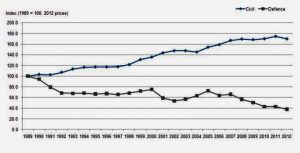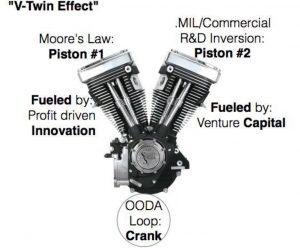Military forces of sovereign nations face an accelerating threat from commercial off the shelf (COTS) technologies. Recent examples include:
- Google Earth used by terrorist planners in Mumbai, 2008
- Telegram app used by IS in EU terror attacks, 2016
- WhatsApp used by Turkish coup plotters, 2016
- Weaponised COTS drones used by IS in Iraq, 2016
Problem Statement
The fundamental problem all sovereign military forces face is the convergence of Moore's Law with the inversion of military & commercial Research & Development (R&D) which will place relentlessly increasing pressure on them to accelerate their decision making cycles.
Let's simplify the problem
Coming from an Infantry background, simple and elegant explanations are almost always best. So let's unpack the problem statement by thinking of it as a triangle pointed down. Moore's Law sits top left, the inversion of military & commercial R&D sits top right, and the decision making cycle or 'OODA Loop' (covered in detail below) is located on the triangle point at the bottom.

Moore's Law: Performance doubles each year
Let's begin with Moore's Law. Gordon Moore is a co-founder of Intel and the person credited in 1965 with first observing that transistor density was doubling each year, and accurately predicting it would continue for the foreseeable future. 52 years since this prediction was first published, Moore's Law continues to accurately predict exponential semiconductor performance improvement and price reduction.
In short, a 40 year old developing world farmer with a ubiquitous smart phone possesses (in his hand) nearly 1,000 times more computational horsepower that the National Security Agency (NSA) possessed with the Cray-1 supercomputer in 1977 (the same year the developing world farmer was born), and for a 99.9+% discount.
Military/Commercial R&D inversion
Now let's shift to the inversion of military and commercial R&D. During World War II and the period immediately following, military R&D proportionally dominated combined R&D spending. During that period of time, military related R&D was absolutely dominant. But the rise of two factors eventually led to the R&D inversion. The first factor started in the 1960's. Due to tax law changes, a new class of investment emerged using discretionary risk capital, commonly referred to as venture capital. Venture capital financing existed to profit from technological innovation and, much like a parallel to Moore's Law, started from a very low base in the 1960's to grow exponentially to fund every major technology company that exists today, including Amazon, Apple, Cisco, Facebook, Intel, Google, and Microsoft.
The end of the Cold War was the second factor that resulted in a significant proportional drop in military R&D, with the inflection point occurring in 1989. Where once military R&D dominated in the post WWII environment, today commercial R&D overwhelmingly dominates all R&D investment; and commercial R&D is increasingly accessible, affordable, and capable of being innovatively weaponised for malignant dual use in opposition to sovereign states and the militaries that defend them.
In short, where once the military possessed full spectrum technological dominance prior to this R&D inversion, current military dominance is rapidly narrowing in comparative advantage and collapsing in persistence due to access to faster developing and cheaper commercial technology.

Since 1989 military R&D funding has declined whilst commercial R&D funding has grown.
OODA Loop decision making cycles must accelerate
'Observe, orient, decide, act' otherwise known as OODA Loop is the recurring decision making cycle as postulated by USAF Colonel John Boyd. Boyd developed the OODA Loop concept to explain how to direct efforts to survive and defeat adversaries, specifically for fighter pilots. But the theory has been broadly applied to include not just broad military use but also commercial and learning processes. The four OODA Loop components are described below:
- Observation: the collection of all relevant data
- Orientation: analyse to form perspective
- Decision: course of action based on perspective
- Action: executing the course of action
The dominant factor in OODA Loop Theory is time. The participant who completes the OODA Loop cycle in the shortest period of time wins by compelling the opposition to react to a situation that has already changed. In short, we must think and act faster than our opponents think and act in order to survive and succeed.
The 'V-Twin Effect'
The 'V-Twin Effect' is the interconnected and accelerating forces of Moore's Law combined with the inversion of military/commercial R&D to compel increases in military OODA Loop cycle velocity.
Moore's Law acts as an engine piston fuelled by commercial profit driven innovation. The inversion of military and commercial R&D acts as a second piston fuelled by the growth of venture capital. The military OODA Loop cycles acts as the engine crank being forced by the two pistons to cycle at higher velocity.
In short, external forces will increasingly compel militaries to learn, adapt, innovate, and iterate faster in order to reduce risk of disruption and enhance near future mission success.

Move, Shoot, Communicate, Innovate
The phrase “move, shoot, communicate” is a popular expression used in the military today that refers to an emphasis on the very basic fundamentals of soldiering. Teaching soldiers to be physically fit, how to shoot accurately, and how to communicate effectively before making contact with the enemy is absolutely and fundamentally critical to future success on operations.
An exponentially changing world compels the expansion of this phrase to “move, shoot, communicate, innovate”, and injecting it into the most fundamental level of military culture, in order to counter fast evolving threats both on and over the horizon. The military lexicon must expand beyond just outmanoeuvre to also include out-innovate and out-adapt.
Amazon's founder, and my previous employer, Jeff Bezos promotes a culture of Day 1. This is a culture of high velocity decision making and relentless innovation. In commercial operations, failure is bankruptcy and job loss. In military operations, the consequences of mission failure and lives lost are far greater. In the current geopolitical environment the adoption of this 'D-Day+1' culture is critical to meet and defeat on and over the horizon evolving threats.
In my next article, I will discuss how we can learn to 'move, shoot, communicate, and innovate'.









